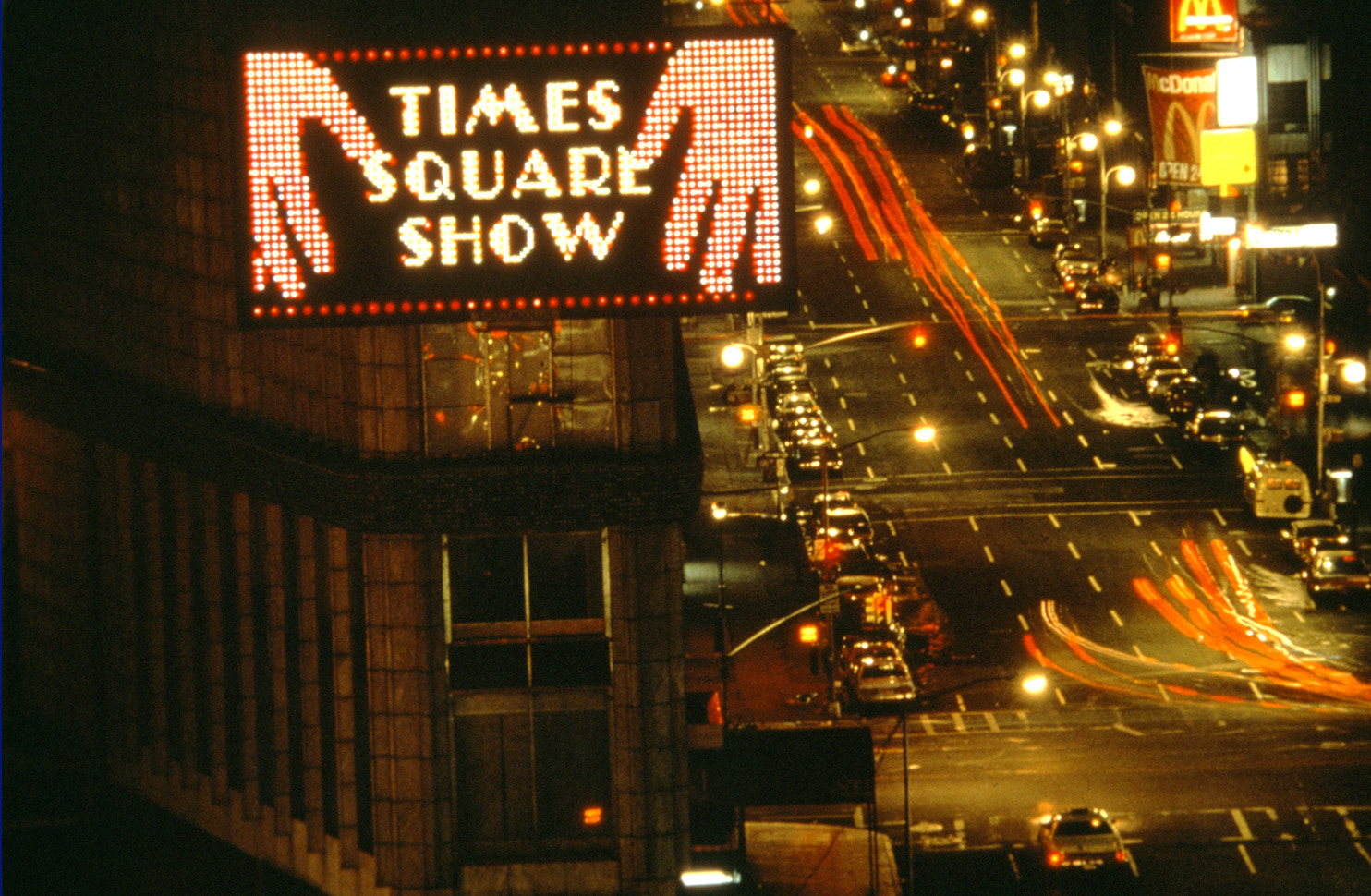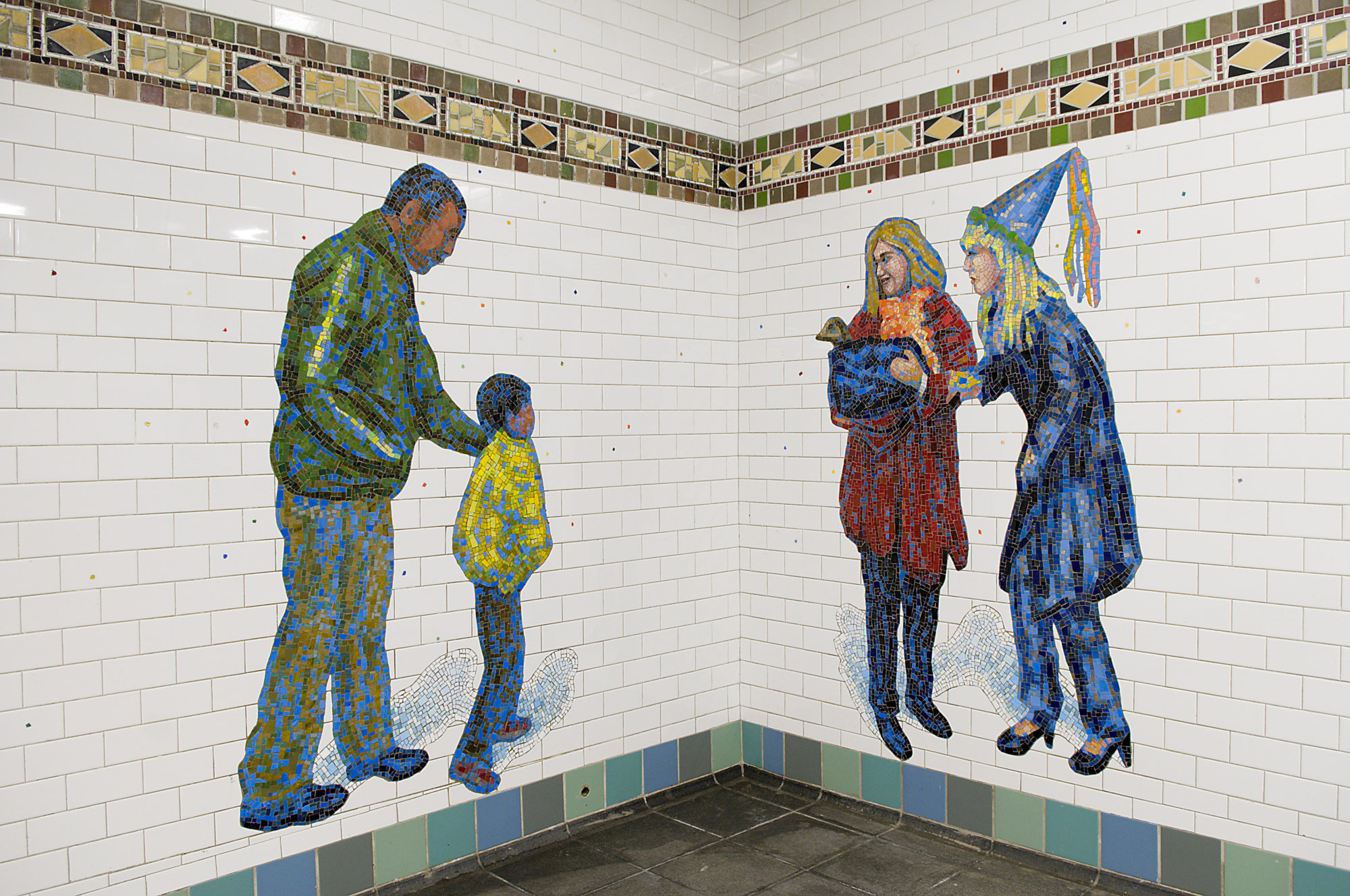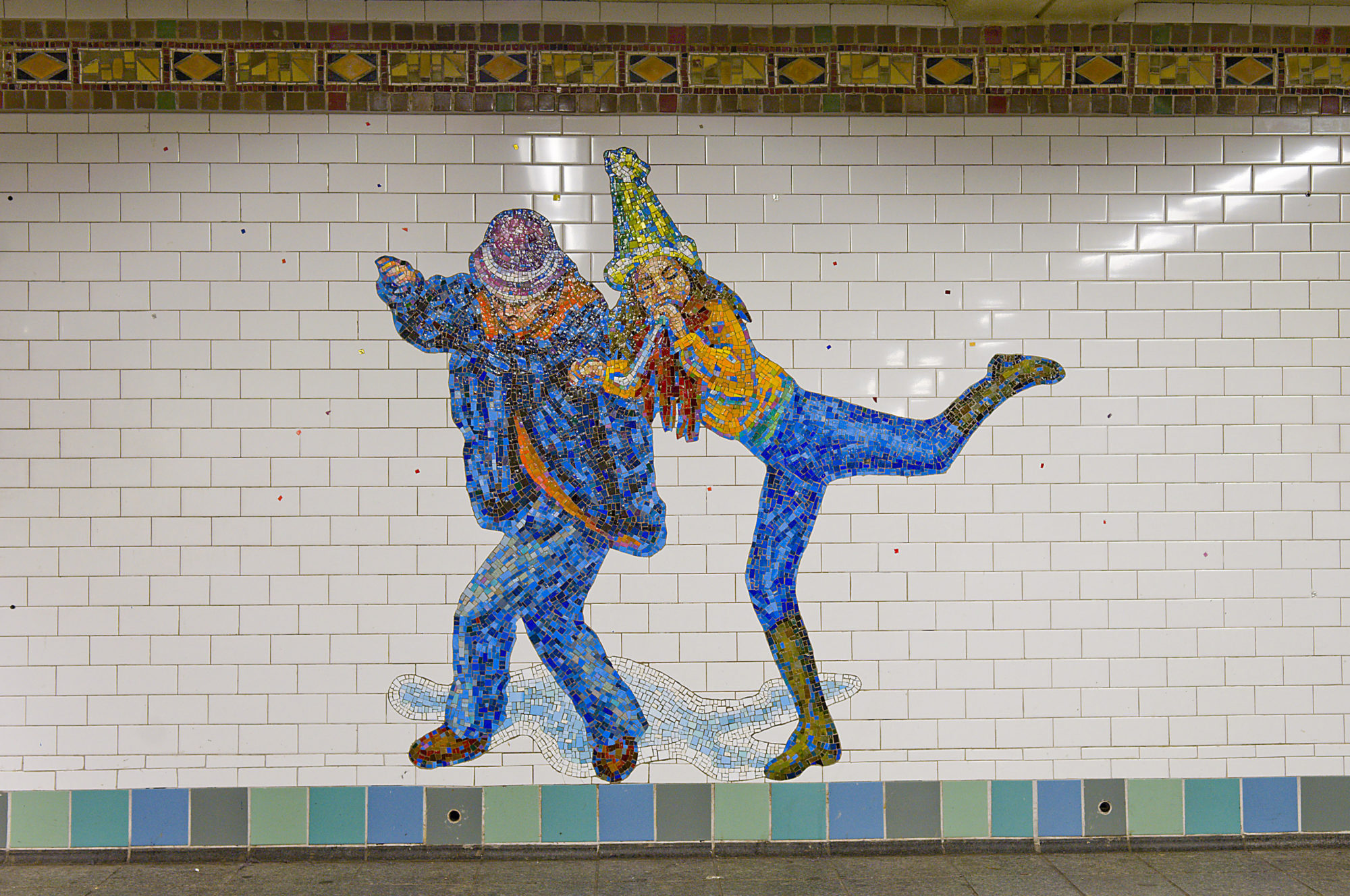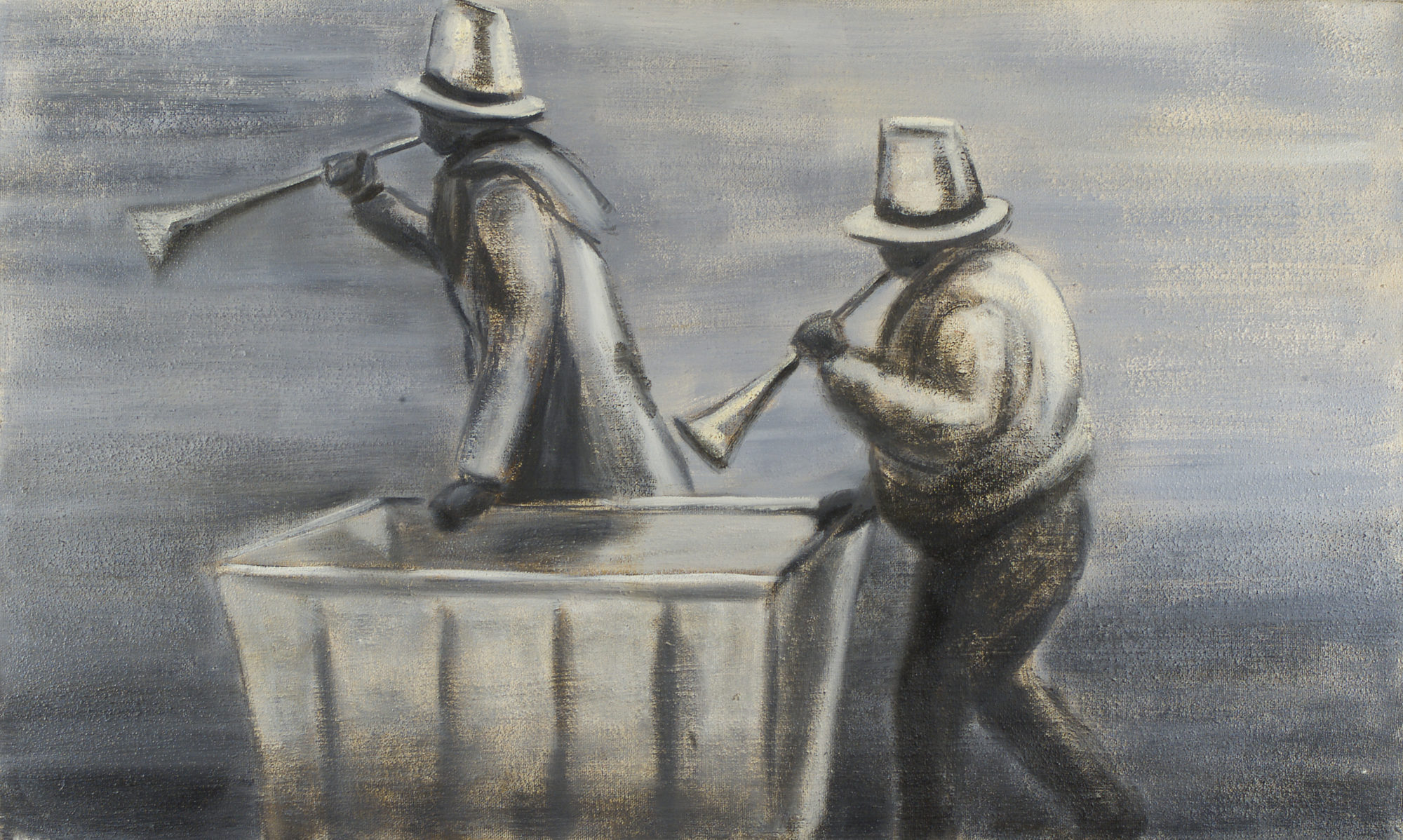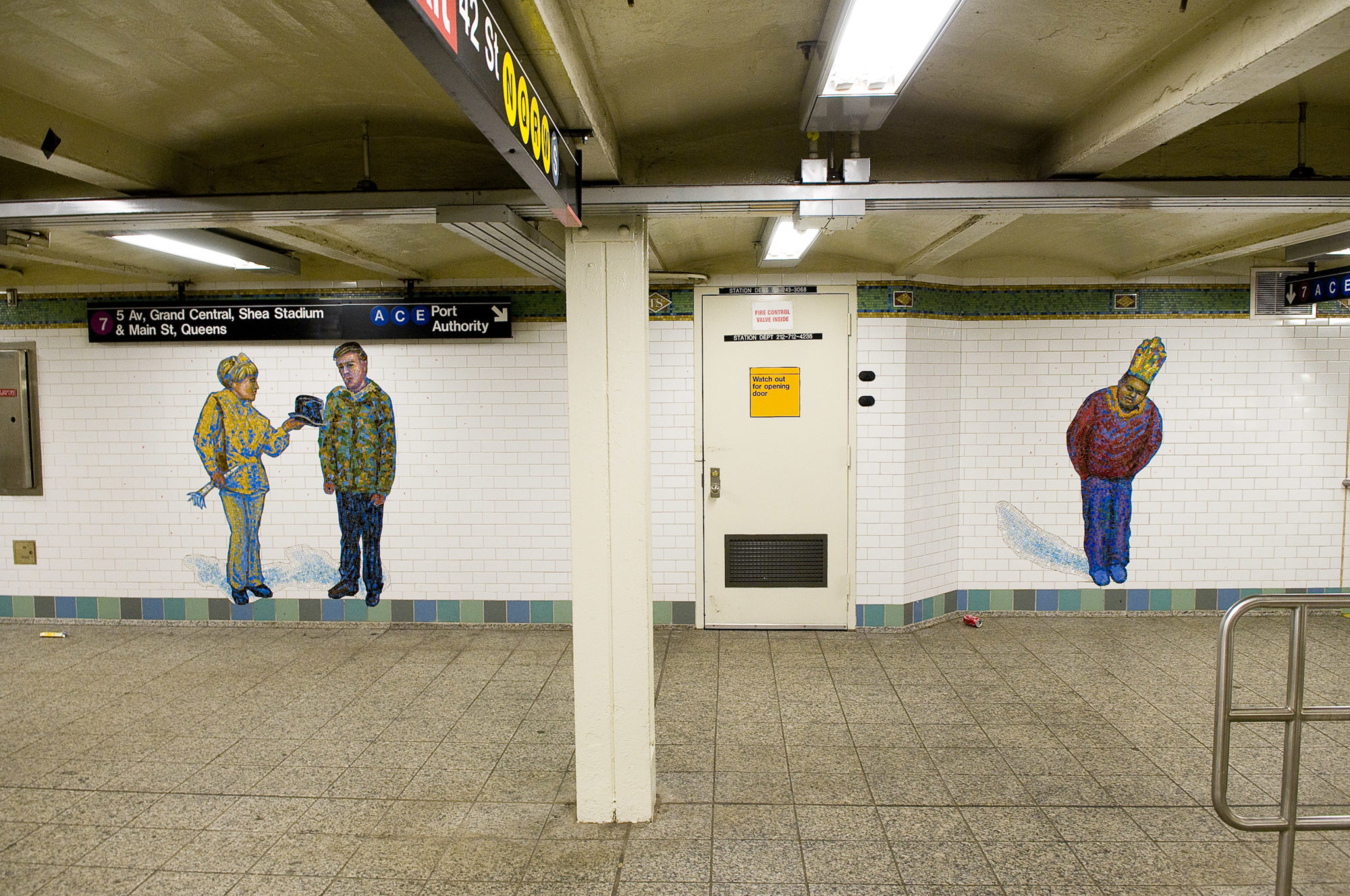Jane Dickson and Times Square
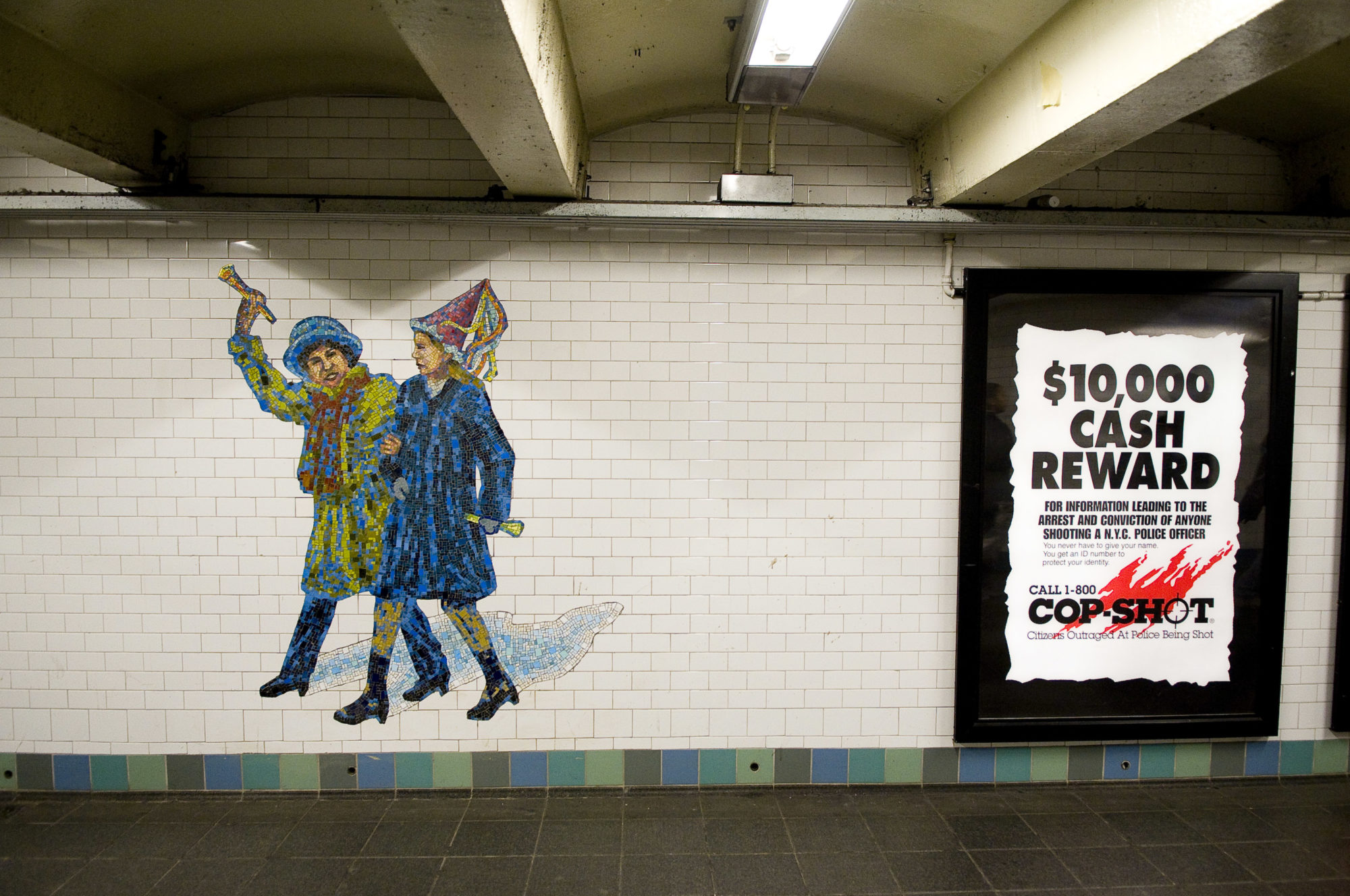
Jane dickson, billboard for the Times Square Show, 1980 [courtesy of the artist]
Share:
Times Square in New York can’t be intellectualized, it has to be felt. Jane Dickson is primarily a painter but also a photographer, curator, and one of the founders of digital art. She has incorporated this urban locus into her practice for four decades, and her work and legacy have therefore become intertwined with this frenetic zone in Manhattan. She has accomplished this entanglement as a careful and lyrical observer. With the 2008 installation of her mosaic cycle Revelers in the Times Square 42nd Street Subway Station, her work has become an important aspect of the place itself. Dickson came to prominence in the New York art world as a part of the late 70s and 80s alternative and punk art scene downtown, as part of the canonical artist cooperative Colab, which staged the Real Estate Show and The Times Square Show in 1980.
Colab led to the creation of the art space ABC No Rio and introduced a generation of new artists including Kiki Smith, Charlie and John Ahearn, Judy Rifka, and Alan Moore, as well as Dickson herself. When she found herself at the controls of the first electronic billboard at 1 Times Square, Dickson used the opportunity to curate projects by her friends and colleagues, helping to further the careers of Jenny Holzer, Keith Haring, and David Hammons, as well as creating some of the first widely seen digital art. This fall will bring the publication of Jane Dickson in Times Square (Anthology Editions, 2018), a monograph on the artist and her relationship to New York’s most notorious and colorful den of revelry and sleaze. Dickson tells ART PAPERS’ Will Corwin all the inspiring and gritty details in her office at Pace University.
Jane Dickson, billboard for the Times Square Show, 1980 [courtesy of the artist]
Will Corwin: Let’s talk about the origin of Revelers. How did your fascination with Times Square begin?
Jane Dickson: In 1978, I answered an ad in The New York Times, “artist wanted, willing to learn computers.” In the 70s there was no such thing as [a computer art program] in any schools yet. I got hired to work on the first digital light board in Times Square. It was above the Zipper: it was where they dropped the ball on New Year’s Eve. The first couple of years I ran the countdown for New Year’s Eve, from behind the sign. It was really great. That was my intro to Times Square, and I worked there from 1978 to 1982. By 82–83 a bunch of the other programming artists there were going to start their own special effects company in Hollywood, and they invited me to go out there with them. I was going to have to learn BASIC programming language, and I got the book and said, “Shoot me. I don’t want to do this.” At the same time I was showing at fun galleries, so I was, like, 21st-century or 19th-century ….
WC: You were showing paintings at the time?
JD: I was showing paintings. I thought, I’m sorry, I’m voting for the 19th-century technique of painting, because it’s tactile in a way that, in digital art, there’s no touch, it’s all cerebral. The sensuality of making messes and getting my hands in there is a really important delight in the process for me.
WC: You were part of Colab, the artist’s collective that orchestrated the famous Real Estate Show on the Lower East side, which eventually led to the creation of ABC No Rio. What was your part in that?
JD: We did Real Estate Show January 1, 1980, and we did Times Square Show June 1, 1980. So, No Rio hadn’t started, but the negotiations had already begun. The city said, “If you get out of the building that you’re trying to squat (which was going to be part of this project that they’re only now starting to build), you can have any other building on the Lower East Side that you want, that the city owns.” The city owned a ton at that point, because it was the “Bronx is burning” era, and the Lower East Side was burning, too. But Times Square Show was sort of our last hurrah. A lot of people [who] were populist got No Rio going, and Colab didn’t do another big show after that.
Jane Dickson, MTA Mural Mosaics from the “Revelers” series at the 42nd Street subway station, 2008 [photo: Tchierry Gourjon; courtesy of the artist]
WC: Were you able to do any art related stuff with the billboard?
JD: I convinced my boss at the billboard to let me run an ad for Times Square Show: I made an animation from the poster, which was also my design of three-card monte. So, when I did that, my boss said “I wouldn’t mind doing more public service art things.”
WC: For free?
JD: Well, I did that one for free. He said, “I don’t want to do them for free, but I’ll do them for really cheap if you can raise some money.” I talked to Jenny Dixon, who was the acting director of the Public Art Fund, and she said, “I like this animation idea. If you can get access, I can get money; we can do this.” So, I said, “I’ll get my boss to let us do this if I get to pick the artists for the first year, because I’ve got this whole cool posse that you’ve never heard of, like David Hammonds, Keith Haring, Krash, Edgar Heap of Birds, Jenny Holzer. I said to Jenny Holzer, who was doing [text on] paper cups at the time, “Jenny, this lightboard thing, you might like it.” I was trying to think of people whose work was graphic and would translate into this crude system.
Back to Colab: everyone has a different story of what Colab was, and it was a million things, but to me it was about this idea of stone soup—that everybody thought they were starving and that they had no prospects to ever get noticed in any way. On the other hand, everybody has something, and in my case the something was the billboard. I thought, “I don’t really like this animation thing, but I know it’s a cool thing, and it would be fun to see what other people would do with it.” For Jenny in particular it was a life-changer. For Keith it was his first public project. Barbara Kruger and Nancy Spero both got censored, so for them it was just yet another brick wall.
Jane Dickson, MTA Mural Mosaics from the “Revelers” series at the 42nd Street subway station, 2008 [photo: Tchierry Gourjon; courtesy of the artist]
WC: How did you deal with that?
JD: We had to negotiate: were we going to do it anyway with the 10 artists that my boss was letting us do? That was my choice—not to go, “Then we won’t do it at all.” It was a compromise, one that I’m still happy with. I was shocked—my boss was a right-to-lifer, I had no idea, and then he made me run [an animation] by some right-to-life artist that was a fetus with its heart beating and a hand. It furthered the conversation, I guess.
WC: Back to Revelers: what was the story behind that work?
JD: I started doing Revelers because Times Square is under siege at New Year’s Eve. We lived on the corner of 43rd and 8th, but on the East Side, so we were always within the Times Square lockdown zone. You were either out of there by 5 pm on New Year’s Eve, and you didn’t come back until the next morning, or you were hunkered down. I don’t really like drunken mobs, and back in the 90s it was dangerous. People got mugged a lot. All the stores would put up plywood over their windows, and nothing was open. I always tried to not be there on New Year’s. The year I was pregnant with my daughter, they thought I was going to have a miscarriage [and I couldn’t travel], so by 9 pm I had a pillow over my head because people start tooting those horns at 6. As soon as I put a pillow over my head I thought, “I hate this, and I make good work about things I hate.” I went out and took a lot of photos of that New Year’s Eve, and I did a whole show of the Revelers paintings [in] 1990.
Jane Dickson, MTA Mural Mosaics from the “Revelers” series at the 42nd Street subway station, 2008 [photo: Tchierry Gourjon; courtesy of the artist]
WC: What’s your relation to the revelers in the images? Do you love them or hate them? I always felt, walking by the mosaic piece in the subway, that it was a very pleasant softening of the horrible experience of New Year’s Eve in Times Square.
JD: The early paintings were bleak. They’re all monochrome; light and dark on an army green or brown. That was partly because I did the paintings after my daughter was born. Thank God she was fine, because it was a difficult pregnancy. I was sitting down all the time, and I did ink wash studies in black and white from those photos. Once she was born, with two little kids it was really hard to get anything done. So, I made these paintings, and I was, like, they’re not going to be about color. They’re just light and dark, because I have a babysitter for another 45 minutes; I’m just going to knock it in. They’re very monochrome and somber paintings. People were trying to celebrate, but the economy had tanked (it was the Savings and Loan Crisis), and it was raining that year. It was not a cheerful thing, and I guess I was feeling a little bleak myself.
WC: But the mosaics in the subway are not somber at all!
JD: When it came time to do the mosaics, first of all: I had come through cancer and was better. I was, like, “I don’t want to be morose anymore.” There’s nothing like having to fight for your life. You think, “Let’s focus on the good stuff,” because ending it doesn’t seem that attractive. I was designing [the mosaics] after the London subway bombings, and I didn’t want to freak people out. I’m scared to go in there—I don’t want to make life harder. I describe the mosaics as cheerful fellow travelers. Maybe I’m Pollyanna-ish. I’m trying to do something to lighten it up. I got all these people; I got some of my students to pose for me, I got my kids to pose, because I wanted to make it as diverse as I possibly could. But when I took their pictures and looked at them, everybody was wearing black! I thought, they’re going to look like a bunch of pilgrims, so I just made up all those colors. These are not stone mosaics, they’re Murano glass, so they come in every glorious color.
By this time my kids were in school. The day my daughter went to full-day pre-K, I went home after I dropped her off, and I took every color and squeezed it out on my palette. While they were little, colors were way too complicated. I was just basically drawing with paint. As I put the paint out, I had the sensation like I was opening the biggest box of fabulous chocolate. I felt like I could taste each of these colors.
Jane Dickson, HornHawker, 1990, oil on canvas [courtesy of the artist]
WC: And Times Square itself, how did the space affect your work?
JD: I was working the night shift on weekends: I’m designing artwork out of lights, it’s on a black screen, and there’s light coming out. Like every artist, I thought, “This is my day job, it has nothing to do with my art, and it won’t affect [my art] at all.” Then I’d go home and start paintings things black because I had gotten entranced with light out of darkness. I liked the quiet and focusing on figuring out the animation, but in my breaks I’d look out the window and start seeing stuff, and then I’d start drawing stuff. I feel like my real art began when I thought, “I’m not doing studies anymore, I’m only going to make work about things that I know something about, and I know a lot about Times Square.” It was scary for a young woman. I was peering into the darkness and trying to show I was tough and brave. Times Square: it’s attractive, and it’s horrifying, but it’s intriguing, and at that point it was extremely raw.
That was around the time the city had gone bankrupt, and really, all the people who had power had moved to the suburbs, and they were, like, “Let’s just let it sink in on itself, and it will all just go down some drain.” When you think about urban planning of the 60s and 70s, it’s so mind-boggling now when you think, what did they think was going to happen to all the people in the cities? I thought, “I want to get in there, even if it’s really messed up. This is the present and the future.” I’m interested in art as a dialogue, and that means I’m not interested in art as a chorus of monologues.
Jane Dickson, MTA Mural Mosaics from the “Revelers” series at the 42nd Street subway station, 2008 [photo: Tchierry Gourjon; courtesy of the artist]
Will Corwin is a New York-based sculptor, writer, and curator. His interviews have been anthologized in The Little Magazine in Contemporary America (University of Chicago Press, 2015), About Trees (Broken Dimanche Press, 2015), and Tell Me Something Good (David Zwirner Books, 2017).
